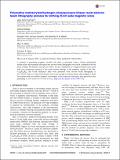Polymethyl methacrylate/hydrogen silsesquioxane bilayer resist electron beam lithography process for etching 25 nm wide magnetic wires
Author(s)
Currivan, Jean Anne; Siddiqui, Saima Afroz; Ahn, Sung-Min; Tryputen, Larysa; Beach, Geoffrey Stephen; Baldo, Marc A.; Ross, Caroline A.; ... Show more Show less
DownloadBeach_Polymethyl methacrylate.pdf (4.462Mb)
PUBLISHER_POLICY
Publisher Policy
Article is made available in accordance with the publisher's policy and may be subject to US copyright law. Please refer to the publisher's site for terms of use.
Terms of use
Metadata
Show full item recordAbstract
A method of patterning magnetic metallic thin films is presented using a bilayer polymethyl methacrylate and hydrogen silsesquioxane electron beam lithography resist mask combined with ion beam etching. The bilayer resist process allows for the combination of a high-resolution resist mask with easy postprocess removal of the mask without damage to the magnetic quality of the film. Co60Fe20B20 and Co/Ni multilayer films were patterned with electron beam lithography at 10–125 keV down to 25 nm wide features with 2 nm average root-mean square edge roughness. Both the in-plane and out-of-plane magnetic anisotropies of the respective film types were preserved after patterning.
Date issued
2014-03Department
Massachusetts Institute of Technology. Department of Electrical Engineering and Computer Science; Massachusetts Institute of Technology. Department of Materials Science and Engineering; Massachusetts Institute of Technology. Department of Physics; Massachusetts Institute of Technology. Research Laboratory of ElectronicsJournal
Journal of Vacuum Science & Technology B: Microelectronics and Nanometer Structures
Publisher
American Institute of Physics
Citation
Currivan, Jean Anne, Saima Siddiqui, Sungmin Ahn, Larysa Tryputen, Geoffrey S. D. Beach, Marc A. Baldo, and Caroline A. Ross. “Polymethyl Methacrylate/hydrogen Silsesquioxane Bilayer Resist Electron Beam Lithography Process for Etching 25 Nm Wide Magnetic Wires.” J. Vac. Sci. Technol. B 32, no. 2 (March 2014): 021601. © 2014 American Vacuum Society.
Version: Final published version
ISSN
2166-2746
1520-8567